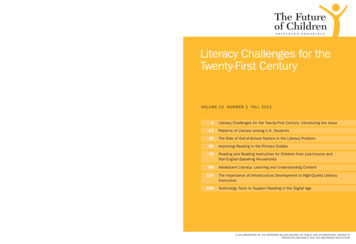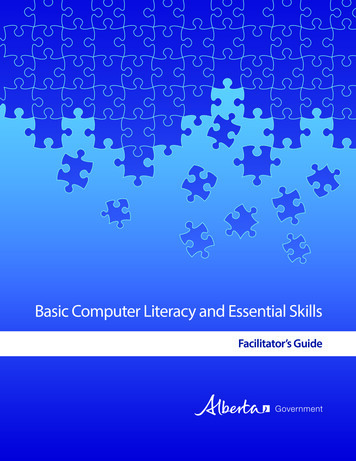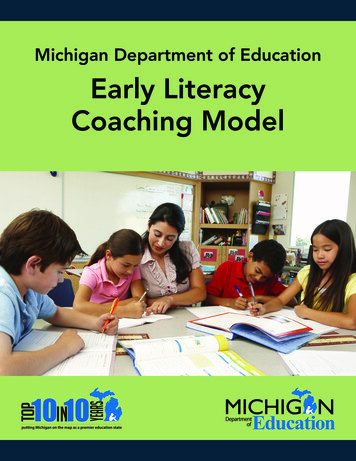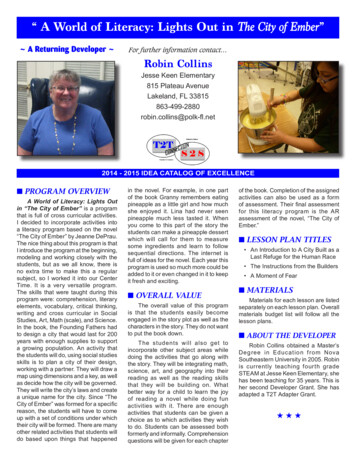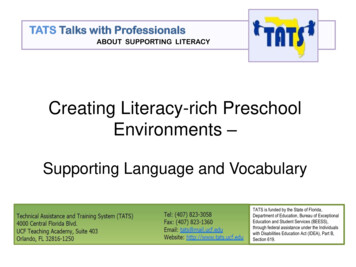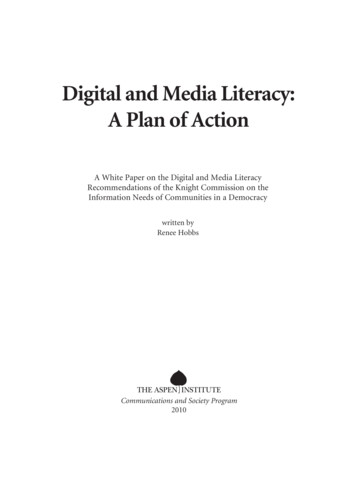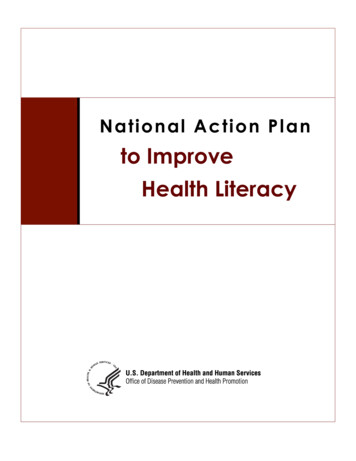
Transcription
Nation al Ac ti on Pl anto ImproveHealth Literacy
Suggested citation:U.S. Department of Health and Human Services, Office of Disease Prevention and Health Promotion.(2010). National Action Plan to Improve Health Literacy. Washington, DC: Author.
ForewordFor more than 30 years, I’ve observed the difficulties many people face as they attempt to use ourhealth care system. I’ve seen firsthand the inequities in health status and access to care and theoutcomes that persist. My own experiences in treating patients, running a large governmentagency and overseeing academic research, have given me a unique perspective about the Nation’shealth care and public health systems, and more importantly the need to make health literacy a publichealth priority.Quite simply, the responsibility is ours as health professionals to communicate in plain language.Without clear communication, we cannot expect people to adopt the healthy behaviors andrecommendations that we champion. When people receive accurate, easy-to-use information about ahealth issue, they are better able to take action to protect and promote their health and wellness. Thatis why health literacy is so critical to our efforts in the U.S. Department of Health and Human Services. Itis the currency for everything we do.Improving health literacy—that is, the degree to which individuals have the capacity to obtain, process,and understand basic health information and services needed to make appropriate health decisions—iscritical to achieving the objectives set forth in Healthy People 2020 and, more broadly, key to thesuccess of our national health agenda.We should address in a sustained manner the problem of health literacy in our Nation with a goal ofimproving health status within and across populations. I remain personally and professionally passionateabout working systematically to attain the highest standard of health for the greatest possible numberof people.Too often, there exists a chasm of knowledge between what professionals know and what consumersand patients understand. Basic health literacy is fundamental to the success of each interaction betweenhealth care professionals and patients—every prescription, every treatment, and every recovery. Basichealth literacy is fundamental to putting sound public health guidance into practice and helping peoplefollow recommendations.The National Action Plan to Improve Health Literacy envisions a restructuring of the ways we create anddisseminate all types of health information in this country. The plan also calls us to ensure that allchildren graduate with health literacy skills that will help them live healthier throughout their lifespan.National Action Plan to Improve Health Literacy iii
ForewordSo many large and small steps are at our disposal. The time to act is at hand. This volume sets forththoughtful, achievable objectives and describes what is required to create and sustain a health literateNation.Accordingly, I wholeheartedly endorse this thoughtful document and the blueprint it offers. Workingcooperatively, let us realize the vision it offers in the lives of people everywhere.Sincerely,Howard K. Koh, M.D., M.P.H.Assistant Secretary for HealthNational Action Plan to Improve Health Literacy iv
ContentsForeword .iiiContents .vSummary .1Introduction .3Understanding and Defining Health Literacy . 4Section 1: Limited Health Literacy as a Public Health Problem . 7Prevalence of Limited Health Literacy (Epidemiology) . 7Health Literacy and Outcomes . 9Innovative Approaches To Improve Health Literacy . 10Section 2: Developing a Societywide Health Response . 13Section 3: Vision and Goals for the Future . 16Goal 1—Develop and Disseminate Health and Safety Information That Is Accurate,Accessible, and Actionable . 18Goal 2—Promote Changes in the Health Care Delivery System That Improve HealthInformation, Communication, Informed Decisionmaking, and Access to Health Services . 25Goal 3—Incorporate Accurate, Standards-Based, and Developmentally Appropriate Healthand Science Information and Curricula in Child Care and Education Through theUniversity Level . 32Goal 4—Support and Expand Local Efforts To Provide Adult Education, English LanguageInstruction, and Culturally and Linguistically Appropriate Health Information Services inthe Community . 35Goal 5—Build Partnerships, Develop Guidance, and Change Policies . 39Goal 6—Increase Basic Research and the Development, Implementation, and Evaluation ofPractices and Interventions To Improve Health Literacy . 43Goal 7—Increase the Dissemination and Use of Evidence-Based Health Literacy Practices andInterventions . 45Section 4: Creating and Sustaining National Action . 48Appendix A: References . 50Appendix B: What You Can Do To Improve Health Literacy. 59Appendix C: Acknowledgments . 63National Action Plan to Improve Health Literacy v
SummaryThis National Action Plan to Improve Health Literacy seeks to engage organizations, professionals,policymakers, communities, individuals, and families in a linked, multisector effort to improvehealth literacy. The plan is based on the principles that (1) everyone has the right to healthinformation that helps them make informed decisions and (2) health services should be delivered inways that are understandable and beneficial to health, longevity, and quality of life. The vision informingthis plan is of a society that: Provides everyone with access to accurate and actionable health information Delivers person-centered health information and services Supports lifelong learning and skills to promote good healthTwo decades of research indicate that today’s health information is presented in a way that isn’t usableby most Americans. Nearly 9 out of 10 adults have difficulty using the everyday health information thatis routinely available in our health care facilities, retail outlets, media, and communities.1, 2, 3 (Referencesare presented in Appendix A.) Without clear information and an understanding of prevention and selfmanagement of conditions, people are more likely to skip necessary medical tests. They also end up inthe emergency room more often, and they have a hard time managing chronic diseases, such asdiabetes or high blood pressure.1Health literacy is the degree to which individuals have the capacity to obtain, process, and understandbasic health information and services needed to make appropriate health decisions.4 Limited healthliteracy affects people of all ages, races, incomes, and education levels, but the impact of limited healthliteracy disproportionately affects lower socioeconomic and minority groups. It affects people’s ability tosearch for and use health information, adopt healthy behaviors, and act on important public healthalerts. Limited health literacy is also associated with worse health outcomes and higher costs.5This report contains seven goals that will improve health literacy and suggests strategies for achievingthem:1. Develop and disseminate health and safety information that is accurate, accessible, andactionable2. Promote changes in the health care system that improve health information, communication,informed decisionmaking, and access to health servicesNational Action Plan to Improve Health Literacy 1
Summary3. Incorporate accurate, standards-based, and developmentally appropriate health and scienceinformation and curricula in child care and education through the university level4. Support and expand local efforts to provide adult education, English language instruction, andculturally and linguistically appropriate health information services in the community5. Build partnerships, develop guidance, and change policies6. Increase basic research and the development, implementation, and evaluation of practices andinterventions to improve health literacy7. Increase the dissemination and use of evidence-based health literacy practices andinterventionsMany of the strategies highlight actions that particular organizations or professions can take to furtherthese goals. It will take everyone working together in a linked and coordinated manner to improveaccess to accurate and actionable health information and usable health services. By focusing on healthliteracy issues and working together, we can improve the accessibility, quality, and safety of health care;reduce costs; and improve the health and quality of life of millions of people in the United States.National Action Plan to Improve Health Literacy 2
IntroductionEvery day, people confront situations that involve life-changing decisions about their health. Thesedecisions are made in such places as grocery and drug stores, workplaces, playgrounds, doctors’offices, clinics and hospitals, and around the kitchen table. Only some of these decisions aremade when patients and their health care providers are in a face-to-face consultation; many more aremade when people are on their own and dealing with often unfamiliar and complex information. Forexample, they must figure out what type of health insurance they should choose; how much medicine togive a sick child, using the directions printed on a box; or how to respond to a warning about a severepublic health outbreak in their area. People need information they can understand and use to makeinformed decisions and take actions that protect and promote their health. Yet two decades of researchindicate that today’s health information is presented in a way that isn’t usable by the average adult.Nearly 9 out of 10 adults have difficulty using the everyday health information that is routinely availablein our health care facilities, retail outlets, media, and communities.1, 2, 3At the same time that health-related decisions are becoming more complex, the economic pressure ofrising health care costs and the growing prevalence of chronic disease are creating a shift towardconsumer-driven health care, where consumers are the primary decisionmaker of the health care theyreceive. Public policy is increasingly focused on the role of consumers (the public) in managing their ownhealth in partnership with health care providers.1, 6 To make appropriate health decisions and act onthem, people must locate health information, evaluate the information for credibility and quality, andanalyze risks and benefits. Underlying this shift toward consumer-driven care are assumptions aboutpeople’s knowledge and skills that contradict what we know about health literacy in the United States.This National Action Plan to Improve Health Literacy seeks to engage all people in a linked, multileveleffort to create a health literate society. Healthy People 2010 defines health literacy as the capacity to“obtain, process, and understand basic health information and services needed to make appropriatehealth decisions.”4 The goals and strategies support and will help achieve Healthy People objectives inhealth literacy and related areas, such as chronic diseases. Healthy People is a set of health objectivesfor the Nation to achieve over a decade. The objectives are informed by the best scientific knowledgeand designed to measure the Nation’s health over time.The action plan identifies the overarching goals and highest priority strategies that we should pursue tocreate a health literate society. Health literacy is part of a person-centered care process and essential tothe delivery of cost-effective, safe, and high-quality health services.7, 8 The expected results of striving forNational Action Plan to Improve Health Literacy 3
Introductionthe goals and implementing the strategies are more usable health information; more cost-effective,equitable, safer, and higher quality health services; and eventually improved health outcomes.The action plan identifies the overarching goals and highest priority strategies that we should pursue tocreate a health literate society. Organizations and professional groups can use the action plan as aframework, adapt the goals and strategies to their situation, and decide on specific actions to take.Professionals, public and private sector organizations, communities, and policymakers are the intendedusers of the plan because they are the ones who can organize and take actions and evaluate progresstoward a health literate society. Every organization and professional group involved in the developmentand dissemination of health information and services should have specific goals, objectives, strategies,policies, guidelines, and metrics to ensure that their actions improve health literacy. Some groups mayhave a bigger role than others, but we all have a contribution to make. Appendix B suggests action stepsfor individuals and families to take on their own or in collaboration with groups in their communities.The health literacy action plan is the result of many years of work by numerous public and private sectororganizations and individuals to draw attention to health literacy as a major public health issue. TheHealth Literacy Workgroup of the U.S. Department of Health and Human Services (HHS) led thepreparation of the plan. The plan was based on the 2006 Surgeon General’s Workshop on ImprovingHealth Literacy, a series of town hall meetings in 2007 and 2008, and feedback from stakeholderorganizations in 2009. The release of the plan is only the beginning of a coordinated process that willresult in a society that is more informed, empowered, and engaged in health protection and promotion.Through interconnected, multitier, and multisector approaches, we can improve the accessibility,quality, and safety of health care; reduce costs; and improve the health and quality of life of millions ofpeople in the United States.Understanding and Defining Health LiteracyHealth literacy is a complex phenomenon that involves skills, knowledge, and the expectations thathealth professionals have of the public’s interest in and understanding of health information andservices. Health information and services are often unfamiliar, complicated, and technical, even forpeople with higher levels of education. People of all ages, races, incomes, and education levels—not justpeople with limited reading skills or people for whom English is a second language—are affected bylimited health literacy. According to research from the U.S. Department of Education, only 12 percent ofEnglish-speaking adults in the United States have proficient health literacy skills. The impact of limitedhealth literacy disproportionately affects lower socioeconomic and minority groups.2National Action Plan to Improve Health Literacy 4
IntroductionThe skills of individuals are an important part of health literacy, but health literacy is not only aboutindividuals’ skills. Health literacy in the U.S. reflects what health systems and professionals do to makehealth information and services understandable and actionable. Professionals, the media, and public andprivate sector organizations often present information in ways that make it difficult to understand and acton. Publicly available health information can also be incomplete or inaccurate. Reports from HHS and theInstitute of Medicine (IOM) highlight a key component of health literacy: the interaction between the skillsof individuals and the requirements and assumptions of health and social systems.1, 9 Consequently, theskills of health professionals, the media, and government and private sector agencies to provide healthinformation in a manner appropriate to their audiences are as equally important as an individual’s skills.1The interactions between laypersons and professionals influence the health literacy of individuals andsociety.Health literacy and literacy are closely related but not identical. Literacy is defined as a set of reading,writing, basic math, speech, and comprehension skills. Numeracy, which is part of literacy, implies a“facility with basic probability and numerical concepts.”10 We need these skills to function in societyevery day.11 Early studies in education and adult literacy demonstrated that literacy influences aperson’s ability to access information, use print materials, and participate in society.12 When we applythese skills to a health context—such as reading a nutrition label, getting a flu shot, or managing ahealth condition—we are using health literacy skills that have developed over time. General literacygives us some but not all the skills to understand and communicate health information and concerns.1Years of school completed can be misleading when estimating literacy and health literacy skills. A personcan have completed the required number of years of school and still have limited health literacy. In fact,approximately 45 percent of high school graduates have limited health literacy.2Health literacy requires knowledge from many topic areas, including the body, healthy behaviors, andthe workings of the health system. Health literacy is influenced by the language we speak; our ability tocommunicate clearly and listen carefully; and our age, socioeconomic status, cultural background, pastexperiences, cognitive abilities, and mental health. Each of these factors affects how we communicate,understand, and respond to health information. For example, it can be difficult for anyone, no matterthe literacy skills, to remember instructions or read a medication label when feeling sick.Health information comes from many different sources and is delivered through multiple channels—forexample, discussions with friends and family; TV, radio, and newspapers; schools; libraries; Web sitesand social media; doctors, dentists, nurses, physician assistants, pharmacists, and other healthprofessionals; health educators; public health officials; nutrition and medicine labels; productpamphlets; and safety warnings. Many of these sources present different and possibly conflictinginformation, and some present biased or incomplete information. As a result, people confront acomplex and potentially overwhelming set of health messages every day.National Action Plan to Improve Health Literacy 5
IntroductionTo prevent or manage disease and promote health, Americans need to make sense of the healthinformation they hear, read, and see from all of these sources. Consequently, no single group ororganization can address health literacy issues on its own. Initiatives from all sectors must be linked andmutually supportive to achieve measurable improvements in health literacy across all socioeconomiclevels.All of us must work together to make sure that health information and services are provided in ways thatmeet the needs and interests of all people. Although many individual factors contribute to limited healthliteracy, eliminating barriers and improving the way health care and public health professionals,educators, and the media communicate health information offer the best opportunity to achieve a healthliterate society.1National Action Plan to Improve Health Literacy 6
1SECTIONLimited Health Literacy asa Public Health ProblemSeveral recent events have drawn attention to the challenges of and possible solutions to limitedhealth literacy. In 2000, Healthy People 2010 identified limited health literacy as a public healthproblem and set national objectives for its improvement.4 The oral health field producedA National Call to Action To Promote Oral Health and a research agenda for health literacy in dentistry.In 2004, IOM reported findings that health literacy is critical to improving the health of individuals andthe Nation.1 At the same time, the Agency for Healthcare Research and Quality (AHRQ) published athorough scientific review of the literature on the effect of limited literacy on a wide variety of healthoutcomes.5 Then, in 2006, the U.S. Department of Education released the first-ever national assessmentof the health literacy of English-speaking adults in the United States, showing that limited health literacyis a widespread problem.2Health literacy is increasingly receiving attention from major health professional organizations. TheNational Institutes of Health and AHRQ sponsor a program announcement to support health literacyresearch. Numerous health professional organizations—such as the American College of Physicians, theAmerican Dental Association, the American Medical Association, the American Academy of Pediatrics,and the Association for Clinicians for the Underserved—have made health literacy a priority issue fortheir members. Accreditation organizations are developing standards for health care organizations toassess their performance in improving health literacy. Audit tools—such as the Pharmacy Health LiteracyAssessment Guide (from AHRQ) and the Health Literacy Environment of Hospitals and Health Centers(from the National Center for the Study of Adult Literacy and Learning)—allow organizations to assesstheir own performance in addressing health literacy-related barriers. The United Nations has agreed ona goal of improving health literacy: “We stress that health literacy is an important factor in ensuringsignificant health outcomes and in this regard call for the development of appropriate action plans topromote health literacy.”13Prevalence of Limited Health Literacy (Epidemiology)Recent research highlights the severity of limited health literacy.14 According to Healthy People 2010,everyday health promotion and disease prevention activities, along with effective navigation of today’shealth care system and response to public health alerts and recommendations, require Proficient healthNational Action Plan to Improve Health Literacy 7
Section 1 Limited Health Literacy as a Public Health Problemliteracy.15 Adults with proficient health literacy skills can perform complex and challenging literacyactivities—such as integrating, synthesizing, and analyzing multiple pieces of information in a complexdocument. An example of health material that requires proficient skills is a table of information abouthealth insurance costs based on income and family size. Materials are often written at a reading leveltoo high for most readers,16, 17, 18, 19 and many health care professionals20 use only some of therecommended strategies when working with patients with limited health literacy.Current population data on literacy and health literacy skills in the United States come from the 2003National Assessment of Adult Literacy (NAAL). NAAL is commissioned by the U.S. Department of Educationand measures literacy among adults. National data on adult literacy (which is related to but not the same ashealth literacy) document significant barriers. According to the 2003 NAAL, the percentage of adults withlimited literacy skills has not improved significantly in the past 10 years. For the first time, the 2003 NAALalso studied health literacy. From the more than 19,000 adults surveyed, only 12 percent demonstratedProficient health literacy.2 These data identify limited health literacy as a population-level problem ofenormous proportion, affecting nearly 9 out of 10 English-speaking adults in the United States. There are nonational data on the health literacy skills in native languages of populations in the United States with limitedor no English language skills.The most current summaries of numeracy research paint a dismal portrait.21, 22 A review of research onadult numeracy concluded that research on interventions is insufficient to provide a meaningful directionfor practice or additional research.22 Following its review, the U.S. Department of Education summarized,“research into instructional practices and curriculum content methodologies . . . is largely flawed, lackingin the scientific rigor necessary to make sound inferences” and found “no consistent definition of mathstandards.”22 The U.S. Department of Education recommended a more precise understanding of reasonsfor dropout from developmental math and more data collection on math outcomes, learnercharacteristics, and relationships of characteristics and outcomes.Although limited health literacy affects most adults at some point in their lives, there are disparities inprevalence and severity. Some groups are more likely than others to have limited health literacy. Certainpopulations are most likely to experience limited health literacy: Adults over the age of 65 years Racial and ethnic groups other than White Recent refugees and immigrants People with less than a high school degree or GED People with incomes at or below the poverty level Non-native speakers of EnglishNational Action Plan to Improve Health Literacy 8
Section 1 Limited Health Literacy as a Public Health ProblemOf great concern are the 14 percent of adults (30 million Americans) who are unable to perform eventhe simplest everyday literacy tasks, many of whom are not literate in English. Most of the adults withBelow Basic health literacy skills would have difficulty reading a chart or simple instructions. These sameadults are more likely to report that their health as poor (42 percent) and are more likely to lack healthinsurance (28 percent) than adults with Proficient health literacy.2 Additionally, the 54 million adultswith any type of disability, difficulty, or illness are especially vulnerable and more likely to perform atthe lowest literacy levels.23 Although physician awareness of the Americans with Disabilities Act hasincreased since its passage, adults with disabilities continue to face significant barriers to health care infacilities and communication.24, 25Based on data about students’ literacy skills, limited health literacy is a significant problem for studentsin grades K–12. Each day, 7,000 students drop out of school—1.2 million each year.26 The results fromthe National Assessment of Educational Progress (NAEP) demonstrated “that high school seniors fromlow-income families read on a par with middle school students from more affluent families.”27 However,NAEP scores for all students do not bode well for general literacy. Only 30 percent of fourth-gradestudents and 29 percent of eighth-grade students scored proficient in language arts on the 2005 NAEP.27The differences in scores between States ranged from a high of 44-percent proficient students in bothfourth and eighth grades in Massachusetts to a low of only 18-percent proficient students in fourth andeighth grades in Mississippi.27Health Literacy and OutcomesThe link between limited health literacy and poor health has been well documented. In 2004, both AHRQand IOM published reports with comprehensive reviews of the literature on health literacy and healthoutcomes. Both reports concluded that limited health literacy is negatively associated with the use ofpreventive services (e.g., mammograms or flu shots), management of chronic conditions (e.g., diabetes, highblood pressure, asthma, and HIV/AIDS), and self-reported health. Researchers also found an associationbetween limited health literacy and an increase in preventable hospital visits and admissions.1, 5 Additionalstudies have linked limited health literacy to misunderstanding instructions about prescription medication,medication errors, poor comprehension of nutrition labels, and mortality.28, 29, 30, 31, 32, 33Limited health literacy has psychological costs. Adults with limited health literacy skills report feeling asense of shame about their skill level.34, 35 They may hide their struggles with reading or vocabulary.36As a result of this and other issues, limited health literacy is often invisible to health care providers andother public health professionals.37, 38, 39National Action Plan to Improve Health Literacy 9
Section 1 Limited Health Literacy as a Public Health ProblemBecause of the complexity of health literacy, there are no reliable and valid studies of its full impact oncosts for health care services. The few published studies have focused on the costs generated byindividuals identified as having “low” health literacy. For example, costs
people's knowledge and skills that contradict what we know about health literacy in the United States. This . National Action Plan to Improve Health Literacy. seeks to engage all people in a linked, multilevel effort to create a health literate society. Healthy People 2010. defines health literacy as the capacity to


